Hi all, I am upgrading most of my power tools and need some advice, on the Band Saw is it worth $80.00 to $90.00 more for a 10 inch over a 9 inch, and what tpi for cutting strip wood. Thanks Don
-

Win a Free Custom Engraved Brass Coin!!!
As a way to introduce our brass coins to the community, we will raffle off a free coin during the month of August. Follow link ABOVE for instructions for entering.
You are using an out of date browser. It may not display this or other websites correctly.
You should upgrade or use an alternative browser.
You should upgrade or use an alternative browser.
Hi all, I am upgrading most of my power tools and need some advice, on the Band Saw is it worth $80.00 to $90.00 more for a 10 inch over a 9 inch, and what tpi for cutting strip wood. Thanks Don
What brand are you asking for?
Hi Zoly, No particular brand, normally get my power tools from MENARDS, have already gotten a disk sander, and a bench drill press both work good, so I basically look at the diferent models and pick out the one that seems to meet my needs, not neccesarrly the cheapest but not the most expensive, with a band saw a good fence is a must, and what tpi should I get for cutting strips min. 1/16 inch and go up from there. THANKS Don PS forgot to thank you for checking out the TAOBAO site it is a really difficult site to manuver have regestered but can not seem to complete the purchase as last steps are totally in Chinese my GOOGLE TRANSLATER DOES NOT DO THAT PAGE
- Joined
- Dec 1, 2016
- Messages
- 6,338
- Points
- 728

if you are going to cut strip wood with a band saw you need the widest blade the saw will take. A narrow blade like 1/8 will move and buckle under the pressure of the cut, narrow blade will also tend to twist. the wider blades will tend to stay stable and not move side to side or twist while cutting.
needless to say wide blades do not cut very well on tight curves but that is the point you want a straight cut.
On mine I use a 3/4 wide blade with 3 teeth per inch.
re-sawing is a term used for cutting sheet stock 2 inches and wider and a 3 tooth per inch works great for that. Now if you are ripping sheet stock into sheets then the 3 tooth blade will shatter or chip thin sheets. a 6 tooth might work better for that. What I do is once I cut the sheets then I stack the sheets and cut anywhere from 3 to 8 sheets at a time.
http://www.woodworkersjournal.com/benchtop-band-saw-reviews/
needless to say wide blades do not cut very well on tight curves but that is the point you want a straight cut.
On mine I use a 3/4 wide blade with 3 teeth per inch.
re-sawing is a term used for cutting sheet stock 2 inches and wider and a 3 tooth per inch works great for that. Now if you are ripping sheet stock into sheets then the 3 tooth blade will shatter or chip thin sheets. a 6 tooth might work better for that. What I do is once I cut the sheets then I stack the sheets and cut anywhere from 3 to 8 sheets at a time.
http://www.woodworkersjournal.com/benchtop-band-saw-reviews/
THANKS DAVE, WHAT in cost. DonABOUT THE 10 inch vs the 9 inch is it worth the money to get a 10 inch, a lot of difference
OOPS I foregot to tell you in desperation of the WHITE SPOTS caused by the acelerator, while using my NAIL POLISH REMOVER WIT 100% aceton breaking a couple pieces apart I tried son on the really bad spots and the disapeared I then cleaned all of it, SO FAR HAS BEEN GOOD DO NOT KNOW WHY THAT WORKED WILL SEND YOU A PICTURE.
- Joined
- Dec 1, 2016
- Messages
- 6,338
- Points
- 728

THANKS DAVE, WHAT in cost. Don ABOUT THE 10 inch vs the 9 inch is it worth the money to get a 10 inch, a lot of difference
I don't think it matters all that much between a 10 or 9 inch saw what matters the most is what width blade the saw will take.
another thing to consider is the guides and tracking of the blade I use Carter roller guides
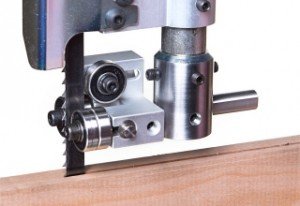
I don't think it matters all that much between a 10 or 9 inch saw what matters the most is what width blade the saw will take.
another thing to consider is the guides and tracking of the blade I use Carter roller guides

How can I tell what kind of roller guides, would it tell me on the box, sorry for stupid questions, but putting out lots of money on new tools, ANOTHER QUESTION do you know of a stand that has casters on it like the work mate my HOBBY ROOM IS GETTING CROWDED, I am also getting the LUTHERS FRIEND THAT YOU SUGESTED. THANKS Don
Dave sorry to bother you, but need info on band saw, the normal MENARDS, Lowes, HOME DEPOT band saws have only 3/8 inch wide blades, found a site that has 3/4 inch blade but no band saws at the price range needed, can you help looked all over amozon could not find the match of blade to band saw. Don
- Joined
- Dec 1, 2016
- Messages
- 6,338
- Points
- 728

Dave sorry to bother you, but need info on band saw, the normal MENARDS, Lowes, HOME DEPOT band saws have only 3/8 inch wide blades, found a site that has 3/4 inch blade but no band saws at the price range needed, can you help looked all over amozon could not find the match of blade to band saw. Don
most saws take a 3/8 blade and that should work for what you plan on doing. No 10 inch saw will take a 3/4 wide blade that is in the 14 to 18 inch class of saw.
roller guides that is an extra you have to buy separate most are block guides a good set of roller guides will cost almost as much as the saw.
you can get a product called cool blocks that set against the side of the blade.
the only saw that comes with roller guides is the Jet and that saw is twice the cost of the others.
ABOUT THE 10 inch vs the 9 inch is it worth the money to get a 10 inch, a lot of difference
10 inch is the distance from the blade to the saw and it does not matter at all so a 9 inch is as good as a 10 inch.
the only saw I would NOT get is the Proxxon it is in the hobby class of machines good for light small work and that is about it. you could not re saw sheets with it. Again there are 3 categories of machines hobby class not much more that toys, home craftsman good for hobby work and commercial class machines.
If you’re a puzzle maker, model builder or hobbyist that often tackles small-scale projects, I have little doubt that the Proxxon will serve you well. If you often tackle full-size projects, but don’t have the space or budget for a full-sized band saw, then the decisions get a bit trickier.
http://www.woodworkersjournal.com/benchtop-band-saw-reviews/
my thoughts on getting tools for a serious model builder are just that MY thoughts.
so personally I would stay away from all the mini tools like the 4 inch table saws, bench scroll and band saws 4 inch disk sanders etc. to me these are just toys and under perform. The biggest issue is they are for light work so you still need bigger tools to cut the material down for the toys to handle.
Most are over priced for what you are getting and you are far better off getting the lower end of the home craftsman tools than the "hobby" tools.
the guy I regularly visit when I need tooling tells me time and time again home craftsman tools are not built for production work you will beat them to death., These table top laser cutters and CNC machines, power tools etc are light duty hobby use. you start using them for production work and in a short time you will kill them.
you will get better results using a craftsman class tool doing lighter duty than you will pushing a light duty hobby tool to its max doing heavier work.
commercial class tools don't count unless to plan on cutting something like 2,000 liner feet of planking per week.
I agree with you Dave, that is why I am upgrading most of my power tools, I have found a 9 inch band saw at Menards where I by most of my stuff they have a Performax band saw 9 inch that takes a 1/2 inch blade in my price range I have a Performmax 5 inch disk sander works quite well for what I am doing, my next tool is the LUTHERIERS FRIEND love the concept, I already have a X-Y Table all I need is some help in how you put it on the drill press, NO INSTRUCTIONS AT ALL, TELL Ev I am sending a wood list now, and I would like to discuss some stuff with you through your email so check it
Well, I have a Proxxon bandsaw, and with a proper blade it can cut formers and FG molding plugs out of a 2x4 birch plank easily. Slowly but easily, and accurately. I have tuned that saw a bit, and the main restriction is now the power: only 80 watts. But it fits nicely to my 180 cm x 360 cm wall-to-wall workshop, and does everything I have asked for it when making r/c airplanes and other related stuff. Latest job was to resaw about 150 metres of 9 x 3,5 mm pine strips out of lumberyard boards. Broke one blade, but I have about a dozen of them, and i can always re-braze and re-set the blades until they are too dull. Any bandsaw straight out-of-the-box cuts more or less crappy until you adjust and tune it to do what's expected. Internet is full of advice how to tune a bandsaw to cut straight and clean.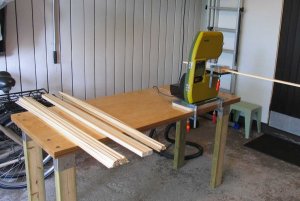
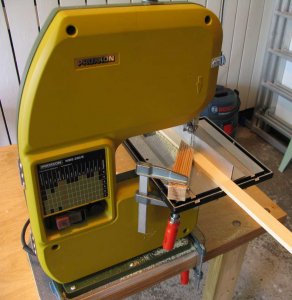


Last edited:
Tuning your Proxxon to cut clean and straight: a few hints and pictures what I have done.
Basically, watch a few youtube videos how to setup and tune a common carpenter's bandsaw to get a general idea about the process: this is good:
and here is another:
But Proxxon is a tiny modellers bandsaw, so it is not made according common woodworking tool standards, so you have to do a couple of modifications first.
1: Crown the wheels: there is no crown originally so you have to grind that crown by yourself. Run the saw with an old toothless ground blade so that there is no danger to saw into your hand during crowning. Put a piece of coarse sandpaper on a stiff stick and use that to do the crowning while running the saw high speed, and grind exactly similar crown to both wheels. The amount of crown should be 0,5 - 1 mm, no more, perfectly spherical as in my picture.
2: Make a new lower blade guide: I fixed a piece of bronze bar into a flat aluminum with a screw, tapped the hole of the original "guide" on the saw frame, and screwed my version in place with a big countersunk screw to clear the blade. Then I put on my diamond blade backwards so that the diamond edge was against the guide, took completely off the upper blade guide, applied correct tension to the blade, and run the saw with slowest speed to cut the guiding slots into the bronze bar so that the blade runs perfectly straight and true on both upper and lower blade wheels. I then reversed the bronze bar around and cut another set of slots to the reversed side of the bar. That way I can use both sides of the bar, but also made another bar as a spare.
3: Make a proper insert to that saw table: I threw away that flimsy too-low plastic bit and replaced it with an aluminum one, and grinded it perfectly flush with the table surface. Then I polished the surface of the table, and deburred all edges of the table slots and grooves to make the workpiece slide smootly during cut.
4: Make a new, sturdy and accurate saw fence: the original is crap and tend to move around during cut. I used an aluminum angle-bar which is attached with bolts tapped into the bar, and wing nuts under the table. Adjustment is made by oblong holes where the fence bolts go thru.
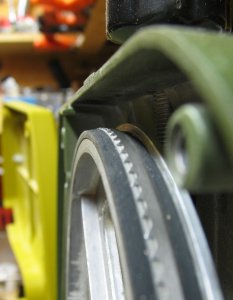
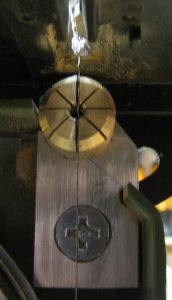
Basically, watch a few youtube videos how to setup and tune a common carpenter's bandsaw to get a general idea about the process: this is good:
1: Crown the wheels: there is no crown originally so you have to grind that crown by yourself. Run the saw with an old toothless ground blade so that there is no danger to saw into your hand during crowning. Put a piece of coarse sandpaper on a stiff stick and use that to do the crowning while running the saw high speed, and grind exactly similar crown to both wheels. The amount of crown should be 0,5 - 1 mm, no more, perfectly spherical as in my picture.
2: Make a new lower blade guide: I fixed a piece of bronze bar into a flat aluminum with a screw, tapped the hole of the original "guide" on the saw frame, and screwed my version in place with a big countersunk screw to clear the blade. Then I put on my diamond blade backwards so that the diamond edge was against the guide, took completely off the upper blade guide, applied correct tension to the blade, and run the saw with slowest speed to cut the guiding slots into the bronze bar so that the blade runs perfectly straight and true on both upper and lower blade wheels. I then reversed the bronze bar around and cut another set of slots to the reversed side of the bar. That way I can use both sides of the bar, but also made another bar as a spare.
3: Make a proper insert to that saw table: I threw away that flimsy too-low plastic bit and replaced it with an aluminum one, and grinded it perfectly flush with the table surface. Then I polished the surface of the table, and deburred all edges of the table slots and grooves to make the workpiece slide smootly during cut.
4: Make a new, sturdy and accurate saw fence: the original is crap and tend to move around during cut. I used an aluminum angle-bar which is attached with bolts tapped into the bar, and wing nuts under the table. Adjustment is made by oblong holes where the fence bolts go thru.


Last edited:

